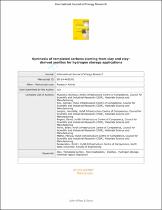 ResearchSpace
ResearchSpace
Synthesis of templated carbon from nanoclay and its zeolitic derivatives for hydrogen storage applications
JavaScript is disabled for your browser. Some features of this site may not work without it.
- ResearchSpace
- →
- Research Publications/Outputs
- →
- Conference Publications
- →
- View Item
| dc.contributor.author |
Musyoka, Nicholas M

|
|
| dc.contributor.author |
Langmi, Henrietta W

|
|
| dc.contributor.author |
Ren, Jianwei

|
|
| dc.contributor.author |
North, Brian C

|
|
| dc.contributor.author |
Mathe, Mahlanyane K

|
|
| dc.contributor.author |
Bessarabov, D

|
|
| dc.date.accessioned | 2014-10-24T13:38:51Z | |
| dc.date.available | 2014-10-24T13:38:51Z | |
| dc.date.issued | 2014-06 | |
| dc.identifier.citation | Musyoka, N.M., Langmi, H.W., Ren, J., North, B.C., Mathe, M. and Bessarabov, D. 2014. Synthesis of templated carbon from nanoclay and its zeolitic derivatives for hydrogen storage applications. In: The 20th World Hydrogen Energy Conference 2014, Kimdaejung Convention Center, Gwangju Metropolitan City, Korea, 15-20 June 2014 | en_US |
| dc.identifier.uri | http://hdl.handle.net/10204/7739 | |
| dc.description | The 20th World Hydrogen Energy Conference 2014, Kimdaejung Convention Center, Gwangju Metropolitan City, Korea, 15-20 June 2014 | en_US |
| dc.description.abstract | Of the many available options for hydrogen storage, carbonaceous materials are gaining increasing attention. In particular, templated carbons have attracted research interest because of the ability to control their pore structure properties with ease. In this study, nanoclay and its recrystallized zeolitic derivatives were used as templating agent for carbon nanostructured materials. The as-received nanoclay and its zeolite X and hydroxysodalite derivatives were initially impregnated with furfural alcohol and later taken through the chemical vapour deposition process using ethylene gas as the gaseous carbon source to completely fill up the pores. Hydrofluoric and nitric acids were used to remove the template and the resulting carbonaceous materials were thoroughly characterized using XRD, SEM, TGA, TEM, N2-BET and also tested for hydrogen storage capacity. The resulting templated carbons were found to be highly ordered and had mimicked the crystal morphology of the templating materials. The samples also exhibited highly improved hydrogen storage capacity. | en_US |
| dc.language.iso | en | en_US |
| dc.relation.ispartofseries | Workflow;13552 | |
| dc.subject | Nanoclay | en_US |
| dc.subject | Zeolite X | en_US |
| dc.subject | Templated carbon | en_US |
| dc.subject | Hydrogen storage capacity | en_US |
| dc.subject | Recrystallization | en_US |
| dc.title | Synthesis of templated carbon from nanoclay and its zeolitic derivatives for hydrogen storage applications | en_US |
| dc.type | Conference Presentation | en_US |
| dc.identifier.apacitation | Musyoka, N. M., Langmi, H. W., Ren, J., North, B. C., Mathe, M. K., & Bessarabov, D. (2014). Synthesis of templated carbon from nanoclay and its zeolitic derivatives for hydrogen storage applications. http://hdl.handle.net/10204/7739 | en_ZA |
| dc.identifier.chicagocitation | Musyoka, Nicholas M, Henrietta W Langmi, Jianwei Ren, Brian C North, Mahlanyane K Mathe, and D Bessarabov. "Synthesis of templated carbon from nanoclay and its zeolitic derivatives for hydrogen storage applications." (2014): http://hdl.handle.net/10204/7739 | en_ZA |
| dc.identifier.vancouvercitation | Musyoka NM, Langmi HW, Ren J, North BC, Mathe MK, Bessarabov D, Synthesis of templated carbon from nanoclay and its zeolitic derivatives for hydrogen storage applications; 2014. http://hdl.handle.net/10204/7739 . | en_ZA |
| dc.identifier.ris | TY - Conference Presentation AU - Musyoka, Nicholas M AU - Langmi, Henrietta W AU - Ren, Jianwei AU - North, Brian C AU - Mathe, Mahlanyane K AU - Bessarabov, D AB - Of the many available options for hydrogen storage, carbonaceous materials are gaining increasing attention. In particular, templated carbons have attracted research interest because of the ability to control their pore structure properties with ease. In this study, nanoclay and its recrystallized zeolitic derivatives were used as templating agent for carbon nanostructured materials. The as-received nanoclay and its zeolite X and hydroxysodalite derivatives were initially impregnated with furfural alcohol and later taken through the chemical vapour deposition process using ethylene gas as the gaseous carbon source to completely fill up the pores. Hydrofluoric and nitric acids were used to remove the template and the resulting carbonaceous materials were thoroughly characterized using XRD, SEM, TGA, TEM, N2-BET and also tested for hydrogen storage capacity. The resulting templated carbons were found to be highly ordered and had mimicked the crystal morphology of the templating materials. The samples also exhibited highly improved hydrogen storage capacity. DA - 2014-06 DB - ResearchSpace DP - CSIR KW - Nanoclay KW - Zeolite X KW - Templated carbon KW - Hydrogen storage capacity KW - Recrystallization LK - https://researchspace.csir.co.za PY - 2014 T1 - Synthesis of templated carbon from nanoclay and its zeolitic derivatives for hydrogen storage applications TI - Synthesis of templated carbon from nanoclay and its zeolitic derivatives for hydrogen storage applications UR - http://hdl.handle.net/10204/7739 ER - | en_ZA |





